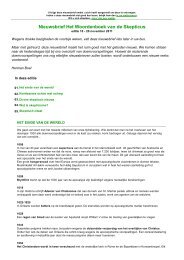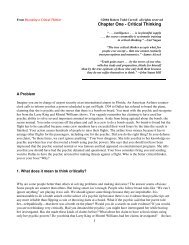A Practical Guide to Critical Thinking - The Skeptic's Dictionary
A Practical Guide to Critical Thinking - The Skeptic's Dictionary
A Practical Guide to Critical Thinking - The Skeptic's Dictionary
Create successful ePaper yourself
Turn your PDF publications into a flip-book with our unique Google optimized e-Paper software.
Greg R. Haskins<br />
3<br />
What <strong>Critical</strong> <strong>Thinking</strong> Is Not<br />
<strong>Thinking</strong> critically is not thinking negatively with a predisposition <strong>to</strong> find fault or flaws. It<br />
is a neutral and unbiased process for evaluating claims or opinions, either someone<br />
else’s or our own.<br />
<strong>Critical</strong> thinking is not intended <strong>to</strong> make people think alike. For one reason, critical<br />
thinking is distinct from one’s values or principles (see Figure 1), which explains why two<br />
people who are equally adept at critical thinking, but have different values or principles,<br />
can reach entirely different conclusions. Additionally, there will always be differences in<br />
perception and basic emotional needs (see Figure 1) which prevent us from all thinking<br />
the same way.<br />
<strong>Critical</strong> thinking does not threaten one’s individuality or personality. It may increase your<br />
objectivity, but it will not change who you are.<br />
It is not a belief. <strong>Critical</strong> thinking can evaluate the validity of beliefs, but it is not a belief<br />
by itself – it is a process.<br />
<strong>Critical</strong> thinking does not discourage or replace feelings or emotional thinking. Emotions<br />
give our lives meaning, pleasure, and a sense of purpose. <strong>Critical</strong> thinking cannot<br />
possibly fulfill this role. Still, emotional decisions that are also critical decisions (such as<br />
deciding <strong>to</strong> get married or have children) should embody critical thinking.<br />
<strong>Critical</strong> thinking does not blindly support everything based on science. For example, our<br />
culture is full of bogus scientific claims that are used <strong>to</strong> market everything from breakfast<br />
cereal <strong>to</strong> breast enhancement pills.<br />
It is also important <strong>to</strong> understand that arguments based on critical thinking are not<br />
necessarily the most persuasive. Perhaps more often than not, the most persuasive<br />
arguments are those designed <strong>to</strong> appeal <strong>to</strong> our basic human/emotional needs rather<br />
than <strong>to</strong> our sense of objectivity. For that reason, it is common for highly persuasive<br />
arguments by politicians, TV evangelists, and sales people, among others, <strong>to</strong><br />
intentionally lack critical thinking. (See pertinent examples in tables 1 through 4.)<br />
Step 1: Adopt the Attitude of a <strong>Critical</strong> Thinker<br />
<strong>The</strong> first step <strong>to</strong> becoming a proficient critical thinker is developing the proper attitude.<br />
Such an attitude embodies the following characteristics:<br />
• Open-mindedness<br />
• Healthy skepticism<br />
• Intellectual humility<br />
• Free thinking<br />
• High motivation<br />
<strong>The</strong> first two characteristics may appear contradic<strong>to</strong>ry, but they are not. <strong>The</strong> critical<br />
thinker must be willing <strong>to</strong> investigate viewpoints different from his or her own, but at the






